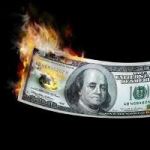 The Federal Reserve is up to its old money printing games once again…
The Federal Reserve is up to its old money printing games once again…
Earlier this month it quietly purchased a cool $43.6 billion in U.S. Treasuries. This included $8.8 billion in 30-year Treasury bonds on May 8. Several days before that, it bought $20.4 billion in 3-year Treasury notes and $14.8 billion in 10-year Treasury notes.
What’s going on? Isn’t the Fed supposed to be tightening – not easing – its balance sheet?
If you recall, after creating roughly $5 trillion in credit out of thin air to paper over the coronavirus fiasco, the Fed’s balance sheet peaked at over $8.9 trillion in April 2022. Since then, through quantitative tightening, the Fed slowly reduced its balance sheet to $6.709 trillion on April 28. But so far in May, the Fed’s balance sheet has ever so slightly increased to over $6.713 trillion.
According to the May 7 Federal Open Market Committee statement, “The Committee will continue reducing its holdings of Treasury securities and agency debt and agency mortgage?backed securities.”
However, if the Fed’s balance sheet is increasing – not decreasing – isn’t the Fed acting in conflict with its policy statement?
By all honest accounts, yes. But in the wide spectrum of gray that ranges between black and white there are technicalities and semantics. In this regard, what the Fed is doing amounts to buying Treasuries on the stealth.
Specifically, the Fed is reinvesting proceeds from maturing bonds. Moreover, this is consistent with policy buried in the Fed’s recent implementation note.
But let’s be real. The Fed is buying bonds. Its balance sheet is expanding. Thus, technicalities aside, the Fed has resumed quantitative easing (QE).
Relying on the Kindness of Strangers
The Fed, in effect, is just getting warmed up for its role as lender of last resort. The U.S. Treasury Department recently reported that foreign Treasury holdings hit a record high of $9.05 trillion in March. That’s up more than $233 billion from $8.81 trillion in February.
However, foreign holdings of Treasuries likely receded in April and May. If you recall, Trump’s tariffs triggered a Treasury sell-off in early April that caused the yield on the 10-year note to spike up from about 4 percent to nearly 4.6 percent in short order.
Certainly, some of the selloff included selling from foreign investors. We’ll have to wait for updated Treasury Department data to confirm.
But what we do know is that in March, China sold off $18.9 billion in Treasuries. We suppose some of the proceeds were invested in gold. In fact, the Peoples Bank of China (PBOC) recently raised gold import quotas, which allow local banks to exchange U.S. dollars directly for gold.
Obviously, the PBOC believes that diversifying out of the dollar is a prudent measure. This has already been underway since at least 2018. Over the last seven years, China has reduced its Treasury holdings from over $1.2 trillion to $765 billion – or by over 36 percent. Much of this selling has occurred since 2022.
This has dropped China to the third largest foreign holder of Treasuries. The United Kingdom is now second with $779 billion. Japan remains the biggest Treasury holder, with nearly $1.13 trillion.
Yet relying on Japan to mop up all the U.S. government debt that’s being issued is absurd. Japan is broke. It has been for many years. It depends on credit that’s created out of thin air to finance its debt. This same credit is also what’s invested in U.S. Treasuries.
Worse than Greece
Japan’s cherry blossom season – sakura – is winding down. So, too, its colossal debt, which has been in perpetual bloom for nearly four decades, is moving towards its end.
Being the world’s largest foreign financier of the U.S. government takes ambition. But now Japan is attempting to tightening its belt while its economy is shrinking. As a result, Prime Minister Shigeru Ishiba, a fiscal hawk, is suffering the wrath of a populace that’s dependent on stimulus.
What Ishiba is attempting to do is the exact opposite of what President Trump’s ‘Big, Beautiful Bill’ is proposing. That is, he’s refusing to finance tax cuts through the issuance of new debt. On Monday, he told parliament:
“Our country’s fiscal situation is undoubtedly extremely poor. Worse than Greece’s.”
If you recall, Ishiba was referring to the euro zone sovereign debt crisis that Greece triggered roughly 15 years ago. At the time, Greece’s its debt-to-GDP ratio was less than 120 percent. By comparison, Japan’s debt-to-GDP ratio is currently about 250 percent.
The difference between Greece and Japan is that Japan finances its debt domestically whereas in Greece, eight out of 10 euros in debt Greece had issued was owed to foreign bondholders. When push came to shove these foreign bondholders quickly moved their capital elsewhere.
Finally, it appears that Japanese citizens have grown wary of loaning cash to their bankrupt government. On Tuesday, Japan experienced one of the worst bond auctions in its history. Yields on the 30-year bond increased to 3.11 percent, the highest since 1999 (back in the 20th century).
Similarly, yields on U.S. government debt are also on the rise…
Warming Up the Printing Presses
Trump’s ‘Big, Beautiful Bill’ will add an additional $3.8 trillion on top of what was already projected to be added to the national debt. So instead of the national debt increasing by $22 trillion to $59 trillion over the next decade, it will spike to nearly $63 trillion.
This bill comes right after Moody’s downgraded U.S. government debt to Aa1 from the top-tier Aaa, citing a “worsening fiscal outlook.” Washington has demonstrated it has no desire to reduce spending, balance the budget, and pay down the debt. How much longer will it take before U.S. government debt is downgraded to junk status?
Not to be outdone by Japan, investors reacted on Wednesday with weak demand for a $16 billion auction of 20-year Treasury bonds. Yields spiked to 5.12 percent. This also pushed the yield on the 10-year Treasury note to about 4.6 percent.
George Saravelos, of Deutsche Bank, provided the following analysis:
“The most troubling part of the market reaction is that the dollar is weakening at the same time. To us this is a clear signal of a foreign buyer’s strike on US assets and the associated US fiscal risks we have been warning for some time. At the core of the problem is that foreign investors are simply no longer willing to finance US twin deficits at current level of prices.”
So, if foreign investors, like China’s and Japan’s central banks, are no longer recycling their dollars into U.S. Treasuries, what are they buying?
Certainly, gold has been getting a lot of attention all year. Lately, it has been trading around $3,300 per ounce. Bitcoin is also another outlet. This week its price spiked up above $110,000.
But these moves are nothing… The Fed’s stealth QE is merely warming up the printing presses.
Later this year, when overstressed credit markets frost over like the Alaskan tundra, the Fed will be called upon, once again, as the lender of last resort. Jerome Powell will be forced to crank up the printing presses to full tilt.
By our back of the napkin calculation, we estimate it will take upwards of $15 trillion in fresh QE liquidity – i.e., credit created out of thin air – to hold the banking system together.
The dollar, in other words, will be trashed accordingly.
[Editor’s note: Gold has already soared past $3,200 an ounce. But with this ‘backdoor’ strategy, you can gain exposure to over an ounce for just $20. The stage is set for a major gold boom. Don’t miss out—click here for urgent details on the #1 gold play of the year!]
Sincerely,
MN Gordon
for Economic Prism
Return from Warming Up the Printing Presses to Economic Prism





No one talks about the problem with our financial system…usury. OUTLAW USURY and you will change the world without changing the world.. We don’t need a banking business only a banking service run locally. Interest is unearned and undeserved and used to be illegal and a sin. Until this banking system is in the dustbin and congress is the one printing money again, at NO INTEREST, NOTHING will change. The banking system itself is the devil